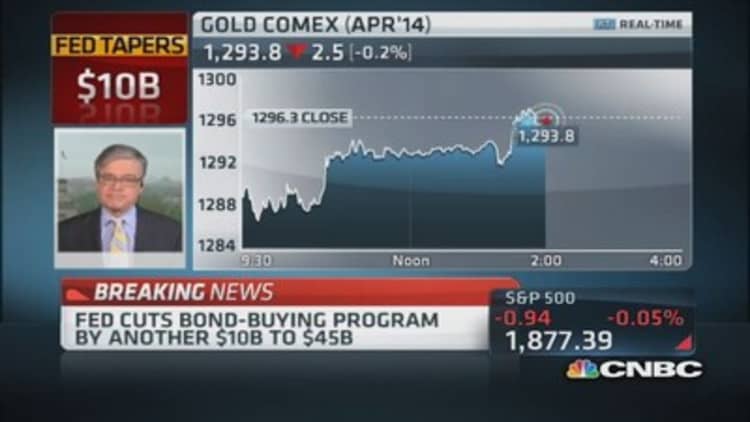
Despite a backdrop of slowing first-quarter economic activity, the Federal Reserve voted Wednesday to continue reducing its monthly stimulus program.
In a move that met market expectations, the U.S. central bank cut back its bond purchases to $45 billion a month, which is $40 billion less than the original total in a program that has swelled the Fed balance sheet to more than $4.3 trillion.
The decision came as recent signs showed that first-quarter growth was even weaker than expected. The Commerce Department reported Wednesday that gross domestic product increased just 0.1 percent, a full percentage point below expectations.
Read MoreUS economy crawls in first quarter
Yet the Fed statement did not reflect substantial concerns and in fact agreed with consensus from economists who believe the slowdown will be short-lived and growth will accelerate.
Read MoreCNBC25: Bernanke and Greenspan
"Information received since the Federal Open Market Committee met in March indicates that growth in economic activity has picked up recently, after having slowed sharply during the winter in part because of adverse weather conditions," the statement from the Open Market Committee said. "Labor market indicators were mixed but on balance showed further improvement."
Stocks briefly saw modest gains following the announcement.
"Given the sizable rebounds in retail sales, employment and industrial production in March, it is hard to argue with that assessment," Paul Ashwowrth, chief U.S. economist at Capital Economist, said of the Fed's economic summary. "The rebound came too late to save first-quarter GDP growth, but we expect to see a strong rebound in second-quarter growth."
The market reaction was in contrast to the last Fed meeting in March, when Chair Janet Yellen set off an aggressive sell with comments that the market interpreted to indicate interest rates rising more quickly than expected.

Yellen's post-meeting news conference comments coupled with an economic forecast—the "dots" on the rate expectations graph—created market volatility that may have been quelled following the non-event of this week's meeting.
Read MoreHow does the April statement compare to March?
"What they did was reinstate some calm in terms of policy intentions," Lindsey M. Piegza, chief economist at Sterne Agee, said in a phone interview. "Last month the market inappropriately focused too much on some of that peripheral data—the press conference, the dot plots—and not the Fed's underlying tone, which remains extremely dovish. The committee remains committed to this essential accommodation."
Beyond the fairly buoyant economic outlook, the Fed's statement changed little from previous meetings. There were no dissenting votes.
The committee continued to insist that the reductions in asset purchases—quantitative easing—are "not on a present course" and subject to economic data, though the market broadly expects the program expire by the end of the year.
(How are the markets reacting? for the latest)


